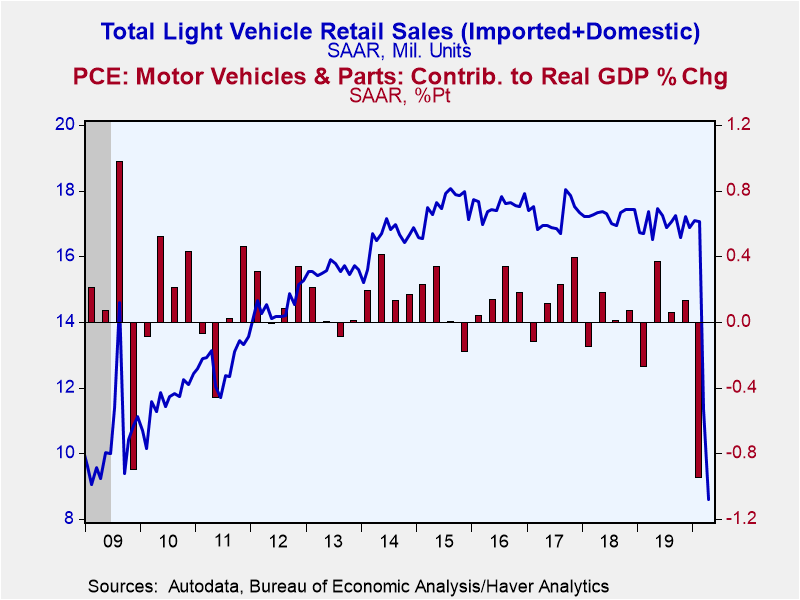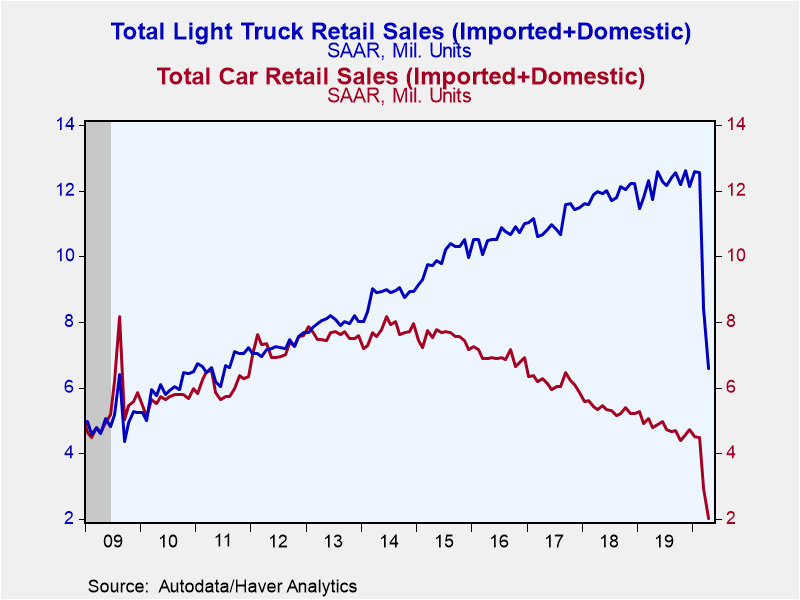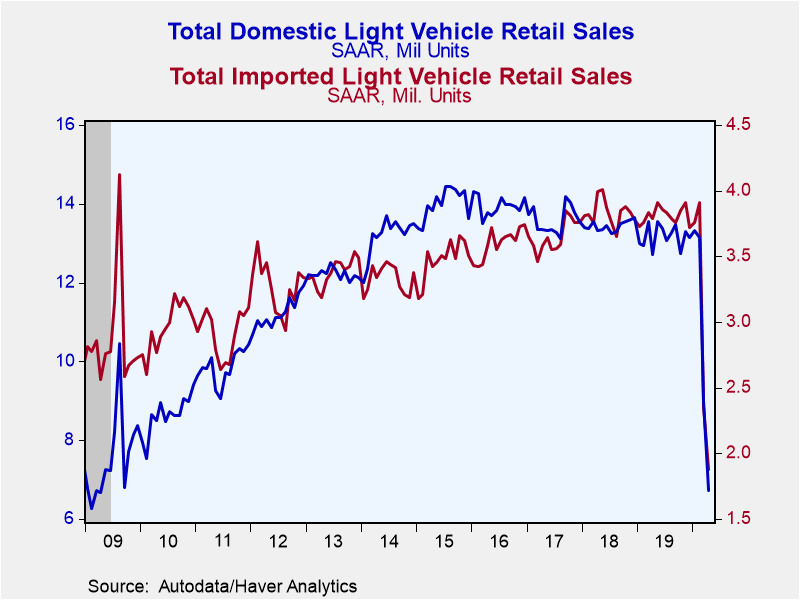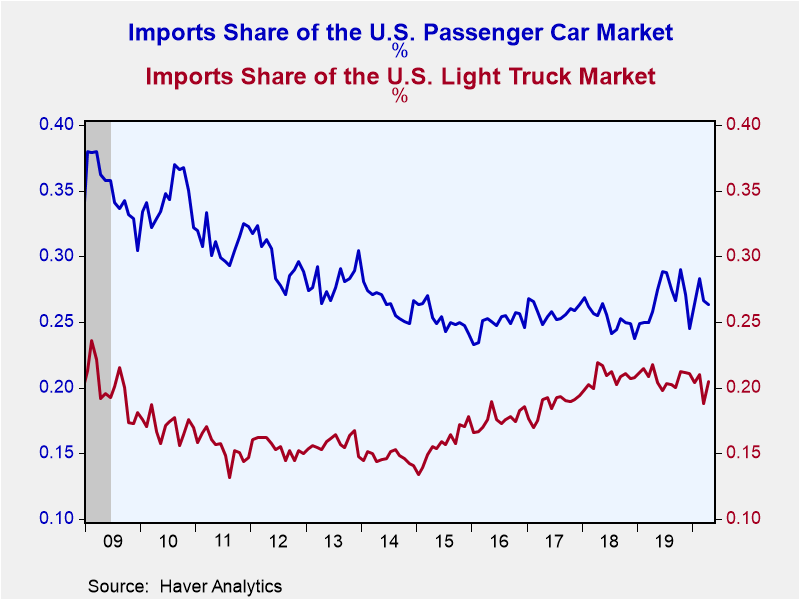 Global| May 01 2020
Global| May 01 2020U.S. Light Vehicle Sales Dive to Record Low
by:Tom Moeller
|in:Economy in Brief
Summary
• Vehicle sales declined 49.6% in last two months. • Car & light truck sales each suffer large losses. Would-be motor vehicle buyers avoided dealer showrooms in April for a second straight month due to higher unemployment, fear of the [...]
• Vehicle sales declined 49.6% in last two months.
• Car & light truck sales each suffer large losses.
Would-be motor vehicle buyers avoided dealer showrooms in April for a second straight month due to higher unemployment, fear of the coronavirus and stay-at-home orders. The Autodata Corporation reported that sales of light vehicles declined last month by 24.1% m/m (-47.9% y/y) to 8.60 million (SAAR) from 11.33 million in March. It was a record low level of sales for the series which dates back to 1980. Sales have been easing since the 2016 peak of 17.55 million units.
Sales of light trucks were off 21.5% (-43.8% y/y) to 6.59 million units. Purchases of domestically-made light trucks fell 23.3% (-42.9% y/y) to 5.23 million units. Sales of imported light trucks weakened 14.6% (-47.1% y/y) to 1.35 million units.
Trucks' share of the U.S. light vehicle market reached a record 76.6%, up from a low of 48.8% during all of 2012.
Auto sales weakened 31.4% (-58.1% y/y) to 2.01 million units and remained below a peak level of 7.71 million unit sales reached in 2014. Purchases of domestically-produced cars fell 31.5% (-58.4% y/y) to 1.48 million units. Sales of imported cars weakened 32.1% (-57.3% y/y) to 0.53 million units.
Imports' share of the U.S. vehicle market rose last month to 21.9%. Imports' share of the passenger car market eased to 26.4%. Imports share of the light truck market improved to 20.5% and remained up from the 12.0% low in January 2015.
U.S. vehicle sales figures can be found in Haver's USECON database. Additional detail by manufacturer is in the INDUSTRY database.
| Light Weight Vehicle Sales (SAAR, Million Units) | Apr | Mar | Feb | Apr Y/Y % | 2019 | 2018 | 2017 |
|---|---|---|---|---|---|---|---|
| Total | 8.60 | 11.33 | 17.05 | -47.9 | 16.99 | 17.27 | 17.23 |
| Autos | 2.01 | 2.93 | 4.49 | -58.1 | 4.80 | 5.36 | 6.16 |
| Domestic | 1.48 | 2.16 | 3.22 | -58.4 | 3.52 | 4.00 | 4.58 |
| Imported | 0.53 | 0.78 | 1.27 | -57.3 | 1.28 | 1.36 | 1.59 |
| Light Trucks | 6.59 | 8.40 | 12.56 | -43.8 | 12.18 | 11.92 | 11.07 |
| Domestic | 5.23 | 6.82 | 9.92 | -42.9 | 9.65 | 9.44 | 9.00 |
| Imported | 1.35 | 1.58 | 2.64 | -47.1 | 2.53 | 2.48 | 2.07 |
Tom Moeller
AuthorMore in Author Profile »Prior to joining Haver Analytics in 2000, Mr. Moeller worked as the Economist at Chancellor Capital Management from 1985 to 1999. There, he developed comprehensive economic forecasts and interpreted economic data for equity and fixed income portfolio managers. Also at Chancellor, Mr. Moeller worked as an equity analyst and was responsible for researching and rating companies in the economically sensitive automobile and housing industries for investment in Chancellor’s equity portfolio. Prior to joining Chancellor, Mr. Moeller was an Economist at Citibank from 1979 to 1984. He also analyzed pricing behavior in the metals industry for the Council on Wage and Price Stability in Washington, D.C. In 1999, Mr. Moeller received the award for most accurate forecast from the Forecasters' Club of New York. From 1990 to 1992 he was President of the New York Association for Business Economists. Mr. Moeller earned an M.B.A. in Finance from Fordham University, where he graduated in 1987. He holds a Bachelor of Arts in Economics from George Washington University.










